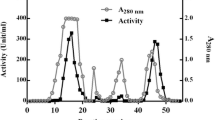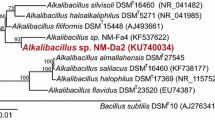Abstract
Halophilic bacterium, producing two extracellular proteases, was isolated from Badab-Sourt, Iran. 16S rDNA analysis shown high similarity with the genera Idiomarina. Maximum secretion of enzymes was observed during the early-stationary phase of bacterial growth. Both extracellular proteases were purified by three purification steps; ammonium sulfate precipitation, Q-Sepharose, and Sephadex G-200 chromatography columns. The molecular weight of purified enzymes was determined by SDS-PAGE gel electrophoresis with approximate masses of 48 and 51 kDa (45.57 and 80.30 U/mg specific activity). Proteases synthesized by strain S-18 were affected by medium compositions. Optimum concentration of substrate, pH, and temperature for both enzymes activity were 0.5% casein, 9.0, and 50 °C. However, purified proteases showed different activity at various salt concentrations, which their maximum activity was determined in the presence of 7.5 and 5% NaCl. The activity of enzymes increased in the presence of metal ions such as Mn2+ and Cu2+ and decreased by the presence of Hg2+ and Fe2+. Both proteases were strongly inhibited by SDS, while DDT, EDTA, and 2-Mercaptoethanol could stimulate their activity. The results of present research might be interesting issue for industrial applications and biotechnological processes.
Graphical Abstract






Similar content being viewed by others
References
Lama L, Romano I, Calandrelli V et al (2005) Purification and characterization of a protease produced by an aerobic haloalkaliphilic species belonging to the Salinivibrio genus. Res Microbiol 156(4):478–484
Maruthiah T, Esakkiraj P, Prabakaran G et al (2013) Purification and characterization of moderately halophilic alkaline serine protease from marine Bacillus subtilis AP-MSU 6. Biocatal Agric Biotechnol 2(2):116–119
Patel R, Dodia M, Singh SP (2005) Extracellular alkaline protease from a newly isolated haloalkaliphilic Bacillus sp.: production and optimization. Process Biochem 40(11):3569–3575
Karbalaei-Heidari HR, Amoozegar MA, Hajighasemi M et al (2009) Production, optimization and purification of a novel extracellular protease from the moderately halophilic bacterium Halobacillus karajensis. J Ind Microbiol Biotechnol 36(1):21–27
Eichler J (2001) Biotechnological uses of archaeal extremozymes. Biotechnol Adv 19(4):261–278
Rao MB, Tanksale AM, Ghatge MS et al (1998) Molecular and biotechnological aspects of microbial proteases. Microbiol Mol Biol Rev 62(3):597–635
Ventosa A, Nieto JJ, Oren A (1998) Biology of moderately halophilic aerobic bacteria. Microbiol Mol Biol Rev 62(2):504–544
Niehaus F, Bertoldo C, Kähler M et al (1999) Extremophiles as a source of novel enzymes for industrial application. Appl Microbiol Biotechnol 51(6):711–729
Van Den Burg B (2003) Extremophiles as a source for novel enzymes. Curr Opin Microbiol 6(3):213–218
DasSarma P, Coker JA, Huse V et al (2010) Halophiles, industrial applications. Encyclopedia of Industrial. Biotechnology. https://doi.org/10.1002/9780470054581.eib439
Enache M, Kamekura M (2010) Hydrolitic enzymes of halophilic microorganisms and their economic values. Rom J Biochem 47(1):46–59
Khansha J, Ranjbaran M, Amoozegar MA (2017) Isolation and identification of halophilic and halotolerant bacteria from Badab-e Surt Travertine Spring, Kiasar, Iran, and investigation of calcite biomineralization induction. Geomicrobiol J 54(1):1–10
Biswas J, Paul AK (2013) Production of extracellular enzymes by halophilic bacteria isolated from solar salterns. Int J Appl Biol Pharm Technol 4(4):30–36
Mehrshad M, Amoozegar MA, Yakhchali B et al (2012) Biodiversity of moderately halophilic and halotolerant bacteria in the western coastal line of Urmia lake. Biol J Microorg 1(2)
Lammert J (2007) Techniques in microbiology: a student handbook, vol 10. Prentice Hall, Upper Saddle River
Abdel-Hamed AR, Abo-Elmatty DM, Wiegel J et al (2016) Biochemical characterization of a halophilic, alkalithermophilic protease from Alkalibacillus sp. NM-Da2 Extremophiles 20(6):885–894
Altschul SF, Madden TL, Schäffer AA et al (1997) Gapped BLAST and PSI-BLAST: a new generation of protein database search programs. Nucleic Acids Res 25(17):3389–3402
Kim O-S, Cho Y-J, Lee K et al (2012) Introducing EzTaxon-e: a prokaryotic 16S rRNA gene sequence database with phylotypes that represent uncultured species. Int J Syst Evol Microbiol 62(Pt 3):716–721
Tamura K, Stecher G, Peterson D et al (2013) MEGA6: molecular evolutionary genetics analysis version 6.0. Mol Biol Evol 30(12):2725–2729
Karbalaei-Heidari HR, Ziaee AA, Schaller J et al (2007) Purification and characterization of an extracellular haloalkaline protease produced by the moderately halophilic bacterium, Salinivibrio sp. strain AF-2004. Enzym Microbial Technol 40(2)
Badoei-Dalfard A, Karami Z, Ravan H (2015) Purification and characterization of a thermo- and organic solvent-tolerant alkaline protease from Bacillus sp. JER02. Prep Biochem Biotechnol 45(2):128–143
Elbanna K, Ibrahim IM, Revol-Junelles A-M (2015) Purification and characterization of halo-alkali-thermophilic protease from Halobacterium sp. strain HP25 isolated from raw salt, Lake Qarun, Fayoum, Egypt. Extremophiles 19(4):763–774
Folin O, Ciocalteu V (1927) On tyrosine and tryptophane determinations in proteins. J Biol Chem 73(2):627–650
Cupp-Enyard C (2008) Sigma’s non-specific protease activity assay-casein as a substrate. J Vis Exp (19). https://doi.org/10.3791/899
Bradford MM (1976) A rapid and sensitive method for the quantification of microgram quantities of protein utilizing the principle of protein-dye binding. Anal Biochem 72:248–254
Li X, Yu H-Y (2012) Purification and characterization of novel organic-solvent-tolerant beta-amylase and serine protease from a newly isolated Salimicrobium halophilum strain LY20. FEMS Microbiol Lett 329(2):204–211
Gupta A, Roy I, Patel RK et al (2005) One-step purification and characterization of an alkaline protease from haloalkaliphilic Bacillus sp. J Chromatogr A 1075(1):103–108
Vidyasagar M, Prakash S, Mahajan V et al (2009) Purification and characterization of an extreme halothermophilic protease from a halophilic bacterium Chromohalobacter sp. TVSP101. Braz J Microbiol 40(1):12–19
Liengme BV (2015) A guide to Microsoft Excel 2013 for scientists and engineers. Academic Press, Amsterdam
Ventosa A, Nieto JJ (1995) Biotechnological applications and potentialities of halophilic microorganisms. World J Microbiol Biotechnol 11(1):85–94
Delgado-García M, Valdivia-Urdiales B, Aguilar-González CN et al (2012) Halophilic hydrolases as a new tool for the biotechnological industries. J Sci Food Agric 92(13):2575–2580
Santos AF, Valle RS, Pacheco CA et al (2013) Extracellular proteases of Halobacillus blutaparonensis strain M9, a new moderately halophilic bacterium. Braz J Microbiol 44(4):1299–1304
Margesin R, Schinner F (2011) Potential of halotolerant and halophilic microorganisms for biotechnology. Extremophiles 5(2):73–83
Sitdhipol J, Visessanguan W, Benjakul S et al (2013) Idiomarina piscisalsi sp. nov., from fermented fish (pla-ra) in Thailand. J Gen Appl Microbiol 59(5):385–391
León MJ, Martínez-Checa F, Ventosa A et al (2015) Idiomarina aquatica sp. nov., a moderately halophilic bacterium isolated from salterns. Int J Syst Evol Microbiol 65(12):4595–4600
Zhang Y-J, Zhang X-Y, Zhao H-L et al (2012) Idiomarina maris sp. nov., a marine bacterium isolated from sediment. Int J Syst Evol Microbiol 62(Pt 2):370–375
Du J, Lai Q, Liu Y et al (2015) Idiomarina atlantica sp. nov., a marine bacterium isolated from the deep sea sediment of the North Atlantic Ocean. Antonie Van Leeuwenhoek 107(2):393–401
Boguslawski G, Shultz JL, Yehle CO (1983) Purification and characterization of an extracellular protease from Flavobacterium arborescen. Anal Biochem 132(1):41–49
Gilbert C, Atlan D, Blanc B et al (1996) A new cell surface proteinase: sequencing and analysis of the prtB gene from Lactobacillus delbruekii subsp. bulgaricus. J Bacteriol 178(11):3059–3065
Hiraga K, Nishikata Y, Namwong S et al (2005) Purification and characterization of serine proteinase from a halophilic bacterium, Filobacillus sp. RF2-5. Biosci Biotechnol Biochem 69(1):38–44
Babe LM, Schmidt B (1998) Purification and biochemical analysis of WprA, a 52-kDa serine protease secreted by B. subtilis as an active complex with its 23-kDa propeptide. Biochim Biophys Acta 1386(1):211–219
Sinsuwan S, Rodtong S, Yongsawatdigul J (2008) Production and characterization of NaCl-activated proteinases from Virgibacillus sp. SK33 isolated from fish sauce fermentation. Process Biochem 43(2):185–192
Izotova LS, Strongin AY, Chekulaeva LN et al (1983) Purification and properties of serine protease from Halobacterium halobium. J Bacteriol 155(2):826–830
Gomes J, Steiner W (2004) The biocatalytic potential of extremophiles and extremozymes. Food Technol Biotechnol 42(4):223–235
Acknowledgements
Authors are grateful Pasture Institute (Amol Branch) for molecular analysis and also thankful Dr. Farzad Mokhtari, Dr. Arastoo Badoei-Dalfard, Mr. Jaber Abbaszadeh, Mr. Shayan Abbasi, Mr. Mohammad Mehdi Choolaei, and Mr. Nima Allah-Yari for their valuable advice. Also, authors wish to thank Neuro-organic Lab. (Institute of biochemistry and biophysics, Tehran University, Iran.)
Author information
Authors and Affiliations
Corresponding authors
Ethics declarations
Conflict of interest
No conflict of interest.
Rights and permissions
About this article
Cite this article
Satari Faghihi, L., Seyedalipour, B., Riazi, G. et al. Introduction of Two Halo-Alkali-thermo-stable Biocatalysts: Purification and Characterization. Catal Lett 148, 831–842 (2018). https://doi.org/10.1007/s10562-018-2295-6
Received:
Accepted:
Published:
Issue Date:
DOI: https://doi.org/10.1007/s10562-018-2295-6




